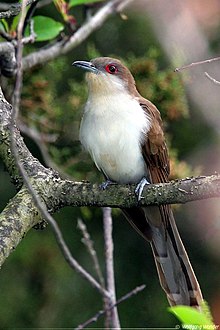Black-billed cuckoo
| Black-billed cuckoo | |
|---|---|
 |
|
| Scientific classification | |
| Kingdom: | Animalia |
| Phylum: | Chordata |
| Class: | Aves |
| Order: | Cuculiformes |
| Family: | Cuculidae |
| Genus: | Coccyzus |
| Species: | C. erythropthalmus |
| Binomial name | |
|
Coccyzus erythropthalmus (Wilson, 1811) |
|
The black-billed cuckoo (Coccyzus erythropthalmus) is a New World species in the Cuculidae (cuckoo) family. The scientific name is from Ancient Greek. The genus name kokkuzo, means to call like a common cuckoo, and erythropthalmus is from eruthros, "red" and ophthalmos, "eye".
It is very similar and overlaps in range with the closely related yellow-billed cuckoo. A distinguishing characteristic of family Cuculidae is laying eggs in the nests of other birds. Although many cuckoos are obligate brood parasites, C. erythropthalmus often incubate their own chicks.
Adults have a long, graduated brown tail and a black, slightly downcurved bill. The head and upper parts are brown and the underparts are white. The feet are zygodactylous. Juveniles are drabber and may contain some rufous coloration on the wing. The adults have a narrow, red orbital ring while the juveniles' is yellow. Black-billed cuckoo chicks have white, sparsely-distributed, sheath-like down that contrasts heavily with their black skin. They also have complex, creamy-colored structures on their mouth and tongue, which may appear like warts or some type of parasitic infection however they are normal for the species.
C. erythropthalmus may be found in a variety of habitats. They are most commonly found around the edges of mature deciduous or mixed forests and much less frequently in coniferous forests. They can also be found in much younger growth forests with a lot of shrubs and thickets. Wetlands with a lot of alder and willow are another prime location to see them. Lastly, they can also inhabit more open areas such as abandoned farmland, golf courses and residential parks. Whatever the habitat may be, they are usually quite well hidden and tend to stick to the edges of these habitats. The chosen habitat must also have a water source nearby such as a lake, river, marsh or pond. On their wintering grounds in South America, they can inhabit tropical rainforests, deciduous or semiopen woodlands as well as scrub forests.
...
Wikipedia

